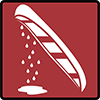
Aquatic invasive species (AIS)
Jasper National Park
Protect park waters
You can prevent the spread of Aquatic Invasive Species (AIS). Before you drive to Jasper, clean, drain, and dry all watercraft and items you plan to put in the water here. Make clean, drain, dry a habit everywhere you go!

Clean all mud, sand, plant, and animal materials from your watercraft and water-related gear.

Drain coolers, buckets, compartments, and other items that may hold water on land before leaving the waterbody.

Dry for a minimum of 48 hours after use in the provinces of British Columbia, Alberta, or the territories of Canada, including use in the national parks AND a minimum of 30 days after use in the United States or provinces other than British Columbia, Alberta and/or the territories of Canada.
Inspection stations
| Maligne Lake Road Inspection Station | July 1 to September 5
|
| Lake Louise Inspection Station (Banff National Park) For non-motorized watercraft |
|
| Lake Minnewanka Inspection Station (Banff National Park) For non-motorized and motorized watercraft |
|
Report aquatic invasive species sightings
Take a picture, note the location, and send it to reportAIS-signalerEAE@pc.gc.ca.
Sightings outside of the national parks can be reported to:
1-855-336-2628 (BOAT) in Alberta and 1-888-933-3722 in British Columbia.
Frequently asked questions
General
What are Aquatic Invasive Species (AIS)?
Healthy aquatic ecosystems are vital to the overall health of our national parks and are threatened by aquatic invasive species. Aquatic invasive species (AIS) are non-native plants, animals, and diseases. Many AIS are harmful to freshwater ecosystems. AIS reproduce fast, they rarely have natural predators and often out-compete native freshwater species.
Aquatic invasive species:
- alter aquatic ecosystems;
- cause irreversible damage;
- impact already vulnerable species at risk; and,
- are introduced by people.
How can the public help prevent the spread of aquatic invasive species?
Everyone can help prevent the spread of AIS in Jasper national park by following Clean Drain Dry procedures and obtaining a mandatory AIS Prevention Permit for all watercraft and water-related gear.
All users of watercraft and water related gear must:
- clean all mud, sand, plant, and animal materials from your watercraft and water-related gear;
- drain coolers, buckets, compartments, and other items that may hold water on land before leaving the waterbody;
- dry for a minimum of 48 hours after use in the provinces of British Columbia, Alberta, or the territories of Canada, including use in the national parks AND a minimum of 30 days after use in the United States or provinces other than British Columbia, Alberta and/or the territories of Canada.
Why are some visitors required to dry their watercraft and gear for 48 hours and others for 30 days?
Watercraft and water-related gear coming from outside of British Columbia, Alberta, Yukon and Northwest Territories are asked to dry for 30 days and those coming from inside of British Columbia, Alberta, Yukon and Northwest Territories are asked to dry for 48 hours. This is because certain areas carry a higher risk of specific types of aquatic invasive species and this helps to eliminate their spread.
Must I clean, drain, and dry watercraft and gear if it’s being used only in the same body of water but more than one time?
Yes, it is recommended to always clean, drain, and dry your watercraft and gear between uses, even if you are using them in the same body of water. This practice helps prevent the spread of aquatic invasive species and ensures that your equipment remains in good condition.
Does Parks Canada conduct boat inspections?
Yes, Parks Canada conducts boat inspections. In 2024, Jasper National Park operates a dedicated inspection station on the Maligne Lake Road near Lake Edith, just before the Sixth Bridge turnoff. Parks Canada staff inspect, clean, and decontaminate non-motorized and electric-propelled watercraft.
What can I expect at the Parks Canada inspection station?
At the inspection stations, trained Parks Canada staff will be available to provide inspections of watercraft and water-related gear for AIS or evidence of potential contamination with AIS. If watercraft and water-related gear are found to have met the Clean Drain Dry protocols and have not been in high risk AIS positive waters they will be permitted to recreate, if they do not meet the protocol the watercraft or gear may undergo a hot-wash or decontamination.
These inspections are available to all watercraft and water-related gear users in Jasper National Park for no cost.
Does a visitor require a permit or inspection before recreating in Jasper National Park?
Jasper National Park collaborates with other mountain national parks to evaluate certification and inspection programs, seeking effective strategies for preventing and managing aquatic invasive species. Currently, there is no requirement for visitors to obtain an aquatic invasive species prevention permit or inspection, but they are strongly encouraged to do so.
Aquatic invasive species
How are aquatic invasive species introduced?
Aquatic invasive species spread when people transfer mud, water, and live or dead organisms (such as plants and fish) between water bodies during activities like boating, canoeing, kayaking, stand-up paddleboarding, and fishing. Motorized watercrafts pose the highest risk due to complex structures and operating systems.
Detailed inspection, and decontamination measures may be necessary to remove all organic matter.
Visitors can prevent the spread of aquatic invasive species by following Clean, Drain, Dry best practices and adhering to regional and local requirements.
What are the impacts of AIS?
Parks Canada is responsible for safeguarding aquatic ecosystems in the mountain national parks. Aquatic invasive species commonly spread through human activities, emphasizing the importance of public education and adherence.
For instance, invasive mussels deplete nutrients vital for native species, including the endangered Athabasca Rainbow Trout. Nutrient depletion affects the entire food web, altering water chemistry and quality.
Additionally, aquatic invasive species significantly impact aquatic recreation. Invasive mussel shells render beaches unsuitable for swimming, while lakes overrun by invasive aquatic plants are no longer ideal for boating. Invasive fish species or fish parasites like whirling disease can reduce or eliminate native sport fish populations, limiting sport fishing opportunities within the parks and downstream areas.
Invasive mussels can also pose risks to water infrastructure, such as irrigation systems and hydroelectric dams.
Have invasive mussels or whirling disease been found in Jasper National Park?
Parks Canada regularly tests for invasive mussels and whirling disease. To date, Jasper National Park is currently free from whirling disease and invasive mussels.
What can the public do if they find AIS?
To help with identification, Parks Canada is asking the public to report AIS sightings to: reportAIS-signalerEAE@pc.gc.ca.
When reporting, it is helpful to know:
- exact location (description to get to the exact spot, GPS coordinates, dropped point on a map, etc.);
- species and distinguishing features (if known);
- date and time of observation;
- photos or videos- high-quality photos or videos to aid in identification;
- contact information so we can reach out if we have questions.
- Date modified :